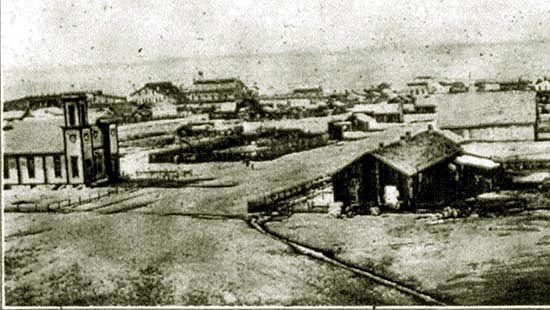
Laramie, 1870. On the left is the Baptish Church. At the top of the image are
the Union Pacific shops.
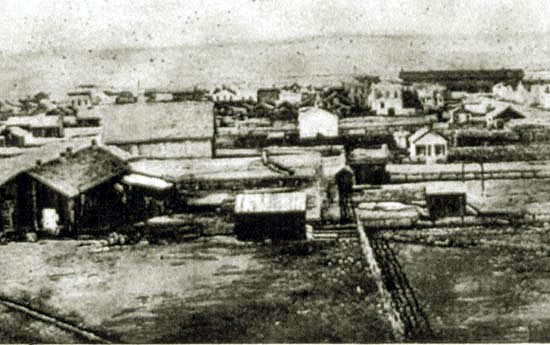
Laramie 1870
In the center of the image, the
white square buidling is the school house. On the right hand side at the end of the street is the
Union Pacific depot.
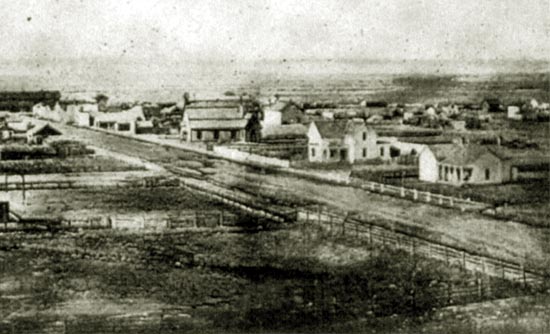
Laramie, 1870.
In the center of the image is St. Matthew's Episcoopal Church, the first
church constructed in Laramie.
Laramie owes its existence to the coming of the Union Pacific railroad and the siting of
Fort Sanders a short distance to the South. Of Fort Sanders only the remains of the guard house are left.
Fort Sanders, originally called Fort John Buford, was established in July, 1866, to protect the Union Pacific
Railroad and the Overland Trail from the depredations of Indians. Thus, in a sense, Laramie is the
third oldest town in Wyoming. Only Ft. Laramie and Ft. Bridger are older. Indeed, Fort Sanders was
designated as the county seat of Laramie County by the Dakota Territorial Legislative Assembly. The county seat was
not moved to Cheyenne until the following year.

Fort Sanders.
Several months after its founding, the Fort was renamed after Brig. Gen.
William P. Sanders, U.S. Volunteers, killed in action at the seige of Knoxville in 1863. Sanders following
his graduation from West Point served as a 2nd Lieutenant in the 2nd U. S. Dragoons during the
Momon War.
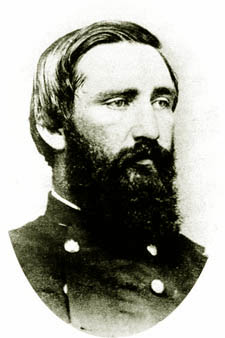 William P. Sanders, Brig. Gen. U.S. Volunteers William P. Sanders, Brig. Gen. U.S. Volunteers
Gen. Sanders illustrates
the divisions created in families and amongst friends by the Cvil War. Gen. Sanders was born in
Kentucky and reared in Mississippi. At West Point only the intervention of his cousin, then Secretary of
War Jefferson Davis saved Sanders from dismissal from the Acadamy. During the war, three of
Gen Sanders' brothers were in Confederate service. Gen. Sanders was killed by a sniper in an attack upon his position
led by his friend and fellow West Pointer, Gen. Edward Porter Alexander, C.S.A. Gen. Alexander learned of the
death of his friend from Union soldiers taken prisoner by C.S.A. forces.
The fort in its layout was similar to the layout of other forts of the same period such as Fort Kearny or Fort
Larned, Kansas. Forts of the age were built to standard plans with modifications as a result of the
availablility of local materials.
Thus, as an example, Fort Union in New Mexico was constructed of
adobe, Ft. Larned was originally of sod replaced later by sandstone, while Fort Sanders was constructed of logs.
The interior of the barracks at the various forts were identical.
The bunks were the same with the same hay-filled mattresses and two soldiers per bunk.
At Fort Sanders,
the stable was 230 feet long. Adjacent to the adjutant's office was a garden. Individual companies also
had their own gardens in which were grown cabbage, beans, peas, lettice, beets and turnips.
The headquarters building was evidently intended to
impress visitors. It was constructed of lath covered with plaster scored to look like stone, complete with
faux lintels. The use of stucco scored to look like stone on cheap buildings dates back to
the Middle Ages. Some of the barons in England, as an example, constructed wooden castles covered with stucco scored to
so as to look like the more expensive stone castles of their more affluent neighboring barons.
The fort was constructed on an elevation.
On its north side was Spring Creek and to the south ran Soldier Creek. Col. Richard Irving Dodge tried his
hand at fishing and later lamented:
The small stream on which Fort
Sanders is situated is extremely pure and clear—a model
trout stream, but containing no trout. In 1868 this
gentleman sent east for eggs, and went to some trouble and
expense in arranging a proper hatching box in the very
head spring of the brook. The eggs were hatched, and
the young trout, apparently perfectly healthy, were, when
largo enough, turned into the brook to take care of
themselves. I am informed (in 1875) by an officer
stationed at Fort Sanders that not a single one of those
trout has ever been seen or heard of since.
Dodge, Richard Irving, The Hunting Grounds of the Great West, A
Description of the Plains, Game, and Indians of the Great
North American Desert, Chatto & Winous, Piccadilly, 1878.
Actually, fish are now found in the streams. Following the closure of the Fort, a portion of its
reservation was turned over to Wyoming Territory for the construction and operation of a fish
hatchery.
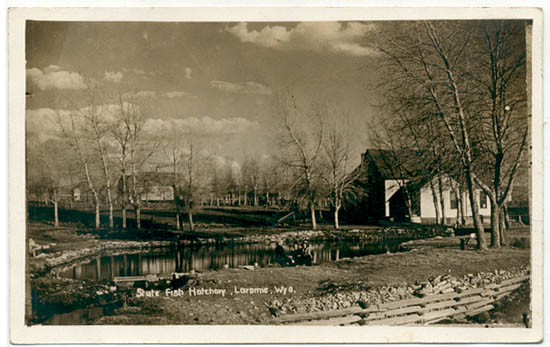
Fish Hatchery, 1915.
On one corner of the orginal fort
there was an octagonal hewn log blockhouse with two rows of rifle ports. Barracks, the Adjutant's office, the
guard house, headquarters building, and bakery were on the edges of the parade. The parade was some
400 feet by 223 feet in the center of which was a 100 ft. high flagstaff built in two sections. The garrison flag,
possibly as large as 36 ft. by 20 ft., would have been visible for miles across the plains. Although there was a
bath tub in the Hospital, at first there were no bathing facilities for the men. Bathing in warm weather was in the
creek. the medical department reported that the primarily medical complaints of the men were constipation, catarrh, tonsillitis, and
chronic rheumatism. Additionally there were respiratory complaints as a result of alkali dust.
The first settler in the area was Philip Mandel (1835-1917) who settled in the
area in 1859. He was later a hay contractor for the Overland Stage and served as one of the first county commissioners
for Laramie County upon its formation.
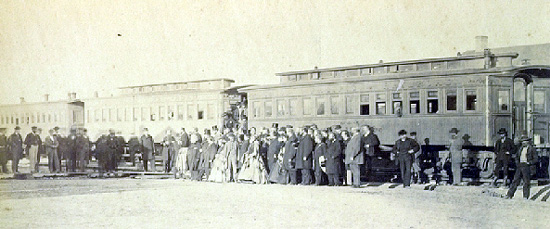
Arrival of Union Pacific officials, Laramie City,
June, 1868.
As indicated by the following photos, Laramie
has received its impetus from being a transportation crossroads and as the location
of the University of Wyoming. The above photo is believed to show the arrival of
Union Pacific President Oliver Ames, Jr. (bearded individual in center of photo), on an inspection tour of the railroad
then under construction. 
Grenvile M. Dodge
The location and the name of the City of Laramie were selected by Gen.
Grenvile M. Dodge, chief engineer of the Union Pacific Railroad. Others in President
Ames' party included Brevet Brig. Gen. John Gibbon, responsible for security
of the railroad against Indians, and Gen. Dodge. Gibbon, whose three brothers
served in Confederate forces, remained loyal to the Union and was one of three on
the peace commission at Appomattox Courthouse which received Gen. Lee's surrender. For more on
Gibbon, see Yellowstone.
By the time the first train
reached Laramie on May 10, 1868, Laramie was a thriving tent and shack city of approximately 2000 population with
a male to female ratio of six to one, 23 saloons, not counting
hog ranches and parlor houses, 1 hotel, no churches, and a reputation for being a bit rough,
Lucius Morris Beebe, the bon vivant and wit, referring to it as a "suburb of Hell". The first hotel, prior to construction of
the Union Pacific Hotel and Eating House, could not be described as offering first class
accommodations.
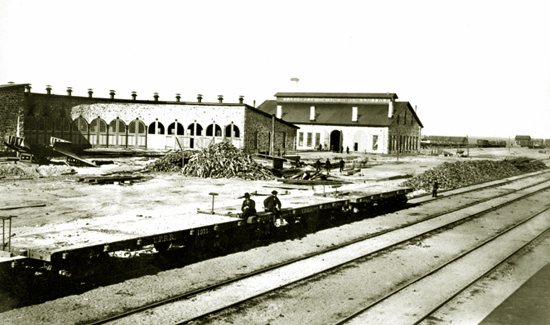
Union Pacific Machine Shops Laramie City, approx. 1870. Photo by
A. J. Russell.
The newly created town was described by California writer Bret Harte in his 1868 "A Run Overland,"
The Overland Monthly:
None of the Laramie City Hotels had
sleeping accommodations while I remained in
the town. I slept in a spare sleeping-car which was there. The
best hotel was a large tent, with rough and dirty pine-board
table and seats. The proprietor and his wife and
child lived, and had their household furniture and bed in one
corner of this tent. There was no screen set up for
privacy. While eating my breakfast on Sunday morning, the
proprietor's wife sat, with her child
upon her knee on the dirty and disordered bed. She was
surrounded by laborers, gamblers, a bar, barber-shop, general dirt and
grease, and most admired disorder. She
looked as if she had not a soul to sympathize with her in the
world.
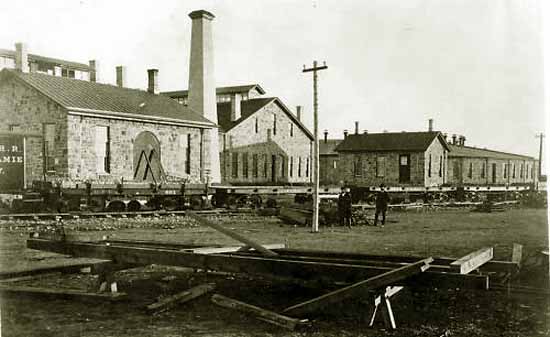
Union Pacific Machine Shops Laramie City, approx. 1870
The first church services were conducted
in a general store owned by Edward Ivinson, who had arrived with his wife Jane on
the first passenger train.
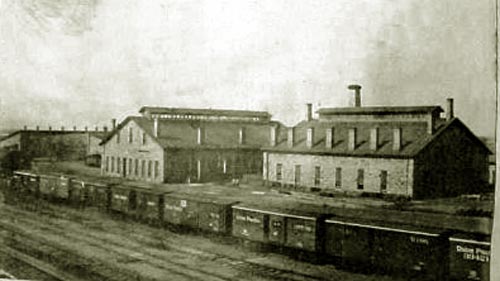
Union Pacific Machine Shops Laramie City, approx. 1905.
On December 16, 1868, the Dakota Legislative Assembly created Albany and Carbon Counties out of the western portion of
Laramie County. In creating the new counties the Legislative Assembly in distant Yankton overlooked one
minor detail. Laramie County was some $40,000.00 in debt. No provision was made for the sharing of that debt with
the new counties. Laramie County sued Albany County to have it share in the debt. The suit was unsucessful. Laramie County got all of the debt. Albany and
Carbon Counties received "fully two-thirds of the wealth and taxable property" without responsibility for the
debt. See Laramie County Com'rs v. Albany County Com'rs, 92 U.S. 307 (1875).
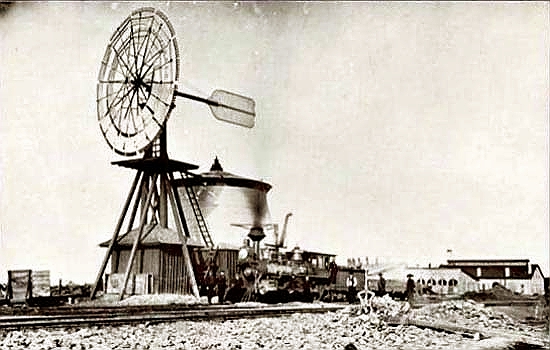
Water Tank, Windmill, and Round House, Laramie City.
Edwin L. Sabin in his 1919 Building the Pacific Railway: The Construction-story of America's First Iron Thoroughfare described early
Laramie:
When in April the land agent of the Union Pacific arrived as the harbinger of
prosperity for the Laramie Plain, 200 people, in wagons, tents, sod-roofed dug-outs and railroad-tie cabins were
camped upon the very spot. Four hundred town lots were sold in the first week;
500 ambitious tenements of business, home and pleasure materialized in the
first fortnight.
May 9 end o-track entered; May 10 passengers and freight and the wheeled
inferno entered. The rakes, touts, cappers, dram vendors, three-card monte men and
poker-kings, their shrill-voiced painted consorts and all the other North Platte-Julesburg-Sidney-Cheyenne
froth and dregs settled like locusts upon the new Laramie. Tie-cutters, Black Hills prospectors and
soldiers from Fort Sanders were overwhelmed by the sudden founts of high carnival widely opened.
The big-game heads, the agates, opals, and mountain amethysts and rubies heaped in the
show-case of the station eating-house were the feeblest of the lures for
incoming tourists; the great water-tank and its wind-mill seventy-five feet
high, on a base twenty-five by fifteen feet—the sparkling streams of water flowing down
the principal streets, failed to wash away the sins of Laramie and the major portion of its
5000 people, until the Vigilantes helped.
For three happy months Laramie roared; within six months it had passed the sear and yellow-leaf stage.
And during those three months, the Big Tent, later made famous in Benton, sojourned on what was later
to become Ivenson Avenue. It was situated about where the Buckhorn famous for the bullet hole in the
rear mirror is now located. At the same time, nine-year old William Octavius Owen arrived with his mother and
two sisters in a covered wagon. He later described
observing his first murder in front of the Big Tent. Within ten minutes after the dirty deed, the
festivities within had resumed. Owen by age 14 was studying surveying and by age 19 was a civil engineer.
He was deputy United States Surveyor. Today, he is remembered for his claim as being the
first person to ascend the Grand Teton in 1898. Nathaniel P. Langford and James Stevenson claimed to have
climbed the peak in 1872. Charles Kieffer claimed to have scaled the peak in 1895.
Laramie Photos continued on next page.
|